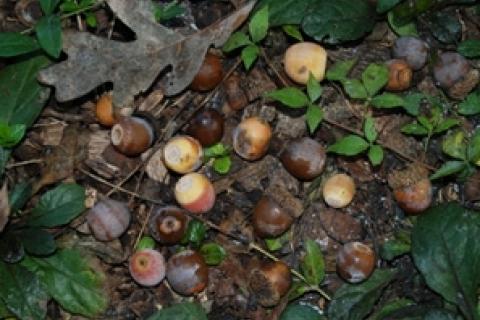
It is no secret that white-tailed deer love acorns, particularly white oak acorns. White oak acorns contain less tannin than red or black oaks and are, therefore, much sweeter.
 Deer will seek the white oak acorns first and then turn to the black oak acorns later.
Deer will seek the white oak acorns first and then turn to the black oak acorns later.
In many regions of the Midwest it is easy to determine when the acorns have begun to drop without entering the woods. Deer will almost totally abandon late afternoon grazing sessions in field edges when acorns have started to drop in the woods. On numerous occasions I have watched as deer literally raced one another at the sound of an acorn falling to the forest floor. They relish white oak acorns and utilize them to add a thick layer of fat prior to the onset of winter.
Acorn production greatly influences deer harvest rates in areas that are dominated by forest cover, according to the Missouri Department of Conservation. Fluctuations in acorn availability can result in annual changes in movement patterns of deer. During years when fewer acorns are available, deer travel more to seek other food sources, and become more vulnerable to hunters. An abundant acorn crop cause deer to scatter, making them less vulnerable to hunters. The variations in the abundance of acorns each year can cause dramatic swings in the annual harvest totals in heavily forested areas like southern Missouri. It is easy to reason that annual changes in harvest totals are not necessarily due to changes in the population, but are a product of fluctuating acorn crops.
The 2012-2013 deer season clearly demonstrated the influence of acorn production on the harvest. The acorn crop was the second lowest since record keeping began 52 years ago. The mast production index was 40 percent lower for red oaks and 76 percent lower for white oaks as compared to 2011. Several regions in thee Ozarks saw increased deer harvests of over 20 percent, while a substantial number of other counties experienced increases over 10 percent.
Many factors can influence acorn production each year ranging from genetics to landscape ecology. Weather, of course, is a major factor. Late frosts and droughts are commonly known factors.
Bowhunters would do well to recognize the fact that while white oaks produce acorns every year, red oak acorns take two years to mature. In years when white oak acorns fail, knowing the location of several acorn producing black oaks are located may put you into good bow hunting early.
However, when white oaks do produce, it is best to concentrate your hunting efforts on them. And when acorn production is spotty, scouting for productive trees is as important as scouting for deer. In fact, you will most often find the two in the same spots.
Recent studies are demonstrating that elevation has a role in acorn production as well. I found early on this year that white oaks on the flats just below ridge tops are the heavy producers. Deer are using them heavily.
Too, I have learned over the years that fertilizing a few of my favorite white oak trees pays big dividends. I have my Bone Collector blind placed near one such tree. The found is covered with big white oak acorns. I expect to be eating venison very soon.
- 2804 views

